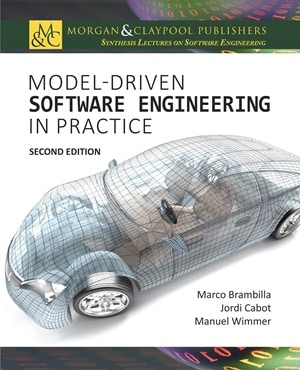We know model-driven engineering has never been a cool tech so tool vendors in the modeling world have always tried to use different names to sell more. Until recently, they were positioning themselves as agile development platforms, rapid application platforms and the like. Now, the new buzzword seems to be low-code platforms.
This term, apparently coined by Forrester, is defined in the Forrester Wave™: Low-Code Development Platforms, Q2 2016 as:
Platforms that enable rapid delivery of business applications with a minimum of hand-coding and minimal upfront investment in setup, training, and deployment.
Sounds familiar right?. Sure, it tries to include not only model-based approaches (in the broadest sense) but also less powerful tools such as limited drag-and-drop visual editors but, to me, this is just the new marketing attempt to keep selling licenses (we already had the CASE trend, then the UML, the MDE trend, the agile trend,…).
Forrester says that there are ALREADY 42 tools in this “new” market but if you look at the names you’ll quickly recognize some of them such as Mendix or OutSystems, both unsurprisingly classified as the best in this new category of tools.
My advice: if you’re still trying to sell a modeling or a code-generation tool, just rebrand yourself and start selling a low-code platform! All it takes is some HTML modifications on your website and you may start getting noticed. Even if this low-code thing is just a make-up of the traditional MDE sector, once Forrester puts a tag on tool category many people follow suit (just search in google for “low-code” and you’ll see the huge attention this buzzword is getting even from websites like Forbes )
At least, there is a positive takeaway from this. We may have to change the name every few years to keep pushing sales up but modeling tools (or whatever you want to call them) have been an important actor in the software market for a long time, which in itself is an important achievement in this rapidly changing sector. Quoting Grady Booch: “History of software engineering is a rise in the levels of abstraction”. This has been true for the last 40 years and I don’t think will ever change.
Developers (and even citizen developers) want faster ways to build bug-free software. We may not agree on the name but we agree on the need and, more importantly, we agree there is money to be made in this market. It may not be easy and may require good marketing efforts beyond good tools but it’s definitely possible. Continue reading on this topic by going over my short article discussing the benefits of low-code for model-driven development.
FNR Pearl Chair. Head of the Software Engineering RDI Unit at LIST. Affiliate Professor at University of Luxembourg. More about me.




Hi Jordi
At last this move is long over due. We in UK pioneered this new way to build and couple of years ago I was asked to write a research paper see here http://www.igi-global.com/chapter/object-model-development-engineering/78620 It really works and does it all…core requirements “no code” but if you need algorithms etc sure you need to code. No code generation uses “declarative” technique with build direct with users in their language! V quick build with easy change BUT be aware very disruptive big vendors and associates will find it hard to swallow but great for customers! Good news no patents so if brave enough to try to build take comfort it will work but does need a business driven approach.
Jodi, is there information on what qualifies as low-code platform? I am not so sure that simple renaming of MDE tool to low-code platform would guarantee sales (at least not in long term).In my experience, with Mendix and Outsystems, there is literally 0% of meta-development needed to start delivering value to business (some-kind of meta-development, integration with other atifatcs, processes is a common practice in MDE).
Andriy, I don’t think the renaming alone is enough but it seems that at least some companies believe it will help them. I doubt there is any kind of precise definition to classify a tool as a low-code platform (beyond the fact that the tool helps you to write less code, which could be done via MDE, via wizards, via predefined tool templates for specific verticals,..). I think it’s more a decision of the own company to brand itself like that.
Regarding your second point, scenarios that require not only using a MDE tool (or a “low-code” one) but also integration/adaptation tasks involving the meta-level (like extending the modeling language to be used) I think are beyond the scope of this Forrester report.
Interesting reading. I see a couple of familiar vendors in this analysis, and many I’ve never heard of. However, the firm I work for isn’t part of the analysis. Your point about companies not branding in this way certainly seems to be true in our case.
Your post about trying to teach students and having problems with the system blowing up, install problems, having to team up multiple students on a system, got to me. Not sure if you are familiar with Pega’s recent University Program?
https://www.pega.com/services/pega-academy/university-academic-program
I would be interested to see your survey results after a class learning to use Pega.
Hi Mike,
I didn´t know you were working at Pega. In fact, to be honest, I had never heard of Pega before so thanks for bringing them to my attention. It would be interesting to know more about how Pega compares with other players.
Jordi, if anyone knows better, please do come forward to correct me, but I think the name “low-code platform” was actually coined by Forrester Research.
This is what the post is already saying Rafael. Am I missing anything?
Indeed. Not sure what I thought I read that made me make that comment. If that timestamp is 11:32 *pm*, beer may have had something to do with it.
At last the recognition that business software must move forward to being a “commoditized” product with the basic requirements no longer needing coders. The way I see it is that MDE is as much about the architecture so I like “MDE no/low code” as a platform that delivers Adaptive solutions that supports the BPM principles/discipline. Analysts such as Forrester and Gartner will now have to dig deep to articulate just how this actually works not just what it delivers…this might be a shock for some vendors……?
Take a look at http://splicer.io. It is the first low code, enterprise mobile stack. As the founder, I pioneered this tech years ago, but could never figure out what market niche it fit into. “Low code” is the best description for it.
The geek in me says “But there’s still just as much code, it’s just generated.. They should have called it low coding” But my marketing side is inserting the phrase into a proposal right now 😉
Leon you make good point there is always “code” but we managed to avoid “generation” as our research established business logic never changes to code once then hand to business to configure in the model in their language what they need. Result is truly disruptive and will change enterprise software just a question of when.
I agree there is always code and while some may not care, as a developer in the “low code” space I would say that without some design you end can end up with a giant mess. My tool of choice is declarative but one can always add code to go around the framework (thus low code not no code). It’s like having a relational database where someone decides to enforce some complex relationships in code only. Now you can’t trust your database to give you all the dependencies.
The beauty is devs and power users can go quickly create functionality. The danger is that devs and power users can go quickly create functionality.
In this article, Jordi Cabot has described how organizations were taking advantage of model-driven engineering tools by showing themselves as agile platforms. He has also stressed on various tools available in the market. I recommend enterprises to get in touch with the best developer who is working on low-code platforms to reduce the development cycle.